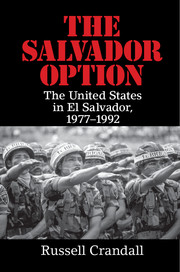Book contents
- Frontmatter
- Dedication
- Epigraph
- Contents
- List of Figures
- List of Organizations
- Acknowledgments
- 1 Introduction
- PART ONE EL SALVADOR IN THE COLD WAR
- PART TWO JIMMY CARTER
- PART THREE RONALD REAGAN
- PART FOUR GEORGE H. W. BUSH
- 39 Elusive Justice
- 40 Pessimism
- 41 Bush Arrives
- 42 Bush, Cristiani, and the 1989 Vote
- 43 Guerrilla Second Final Offensive, November 1989
- 44 Jesuit Killings
- 45 SAMs
- 46 United Nations and Peace
- 47 Demobilization
- PART FIVE POSTWAR
- Notes
- Bibliography
- Index
40 - Pessimism
from PART FOUR - GEORGE H. W. BUSH
Published online by Cambridge University Press: 05 June 2016
- Frontmatter
- Dedication
- Epigraph
- Contents
- List of Figures
- List of Organizations
- Acknowledgments
- 1 Introduction
- PART ONE EL SALVADOR IN THE COLD WAR
- PART TWO JIMMY CARTER
- PART THREE RONALD REAGAN
- PART FOUR GEORGE H. W. BUSH
- 39 Elusive Justice
- 40 Pessimism
- 41 Bush Arrives
- 42 Bush, Cristiani, and the 1989 Vote
- 43 Guerrilla Second Final Offensive, November 1989
- 44 Jesuit Killings
- 45 SAMs
- 46 United Nations and Peace
- 47 Demobilization
- PART FIVE POSTWAR
- Notes
- Bibliography
- Index
Summary
Neither of his [President Reagan's] major objectives – the overthrow of the Sandinista Government in Nicaragua and the military defeat of the leftist guerrillas in El Salvador – is likely to be achieved without the use of American troops.
– New York Times correspondent, 1984We say we are here to fortify democracy. Well, hell, we could be doing that forever.
– American official, 1989Just as Marlow was confronted in Heart of Darkness with the tragic absurdity of Kurtz's claim that “by the simple exercise of our will we can exert a power for good practically unbounded,” so the United States has become disillusioned with the role it has chosen to play in El Salvador.
– U.S. military analyst, 1991“Those Plans Have Gone Nowhere”
During the early years, American policymakers tended to be pessimistic on the Salvadoran government's chances to win the war. These fears largely ebbed during the middle of the decade when it appeared that, through vigorous U.S. support, the government and FAES had the upper hand. Yet the outlook changed again by the late 1980s when even some of the most fervent supporters of U.S. engagement were concluding that it had failed. In November 1989, for example, a former Salvadoran official surveyed the 10 years of American involvement in his country and concluded that “the U.S. wanted to achieve three things: a measure of peace, the respect for human rights, and the institutionalization of democratic processes. All three objectives have failed.” Speaking a year earlier, California congressman George Miller echoed a similar sentiment, observing:
The failure of the Administration's policy of building democracy in El Salvador while defeating the leftist rebels militarily.…In 1984, we were told that the newly elected Government of José Napoleón Duarte, backed to the hilt by Washington, would represent a credible, effective, and moderate force that would implement genuine reform and bring peace to El Salvador. Those plans have gone nowhere.
In 1988, a widely distributed evaluation based on field reporting by four U.S. military officers concluded that “unhappily, the United States finds itself stuck with that war.”
- Type
- Chapter
- Information
- The Salvador OptionThe United States in El Salvador, 1977–1992, pp. 409 - 414Publisher: Cambridge University PressPrint publication year: 2016

